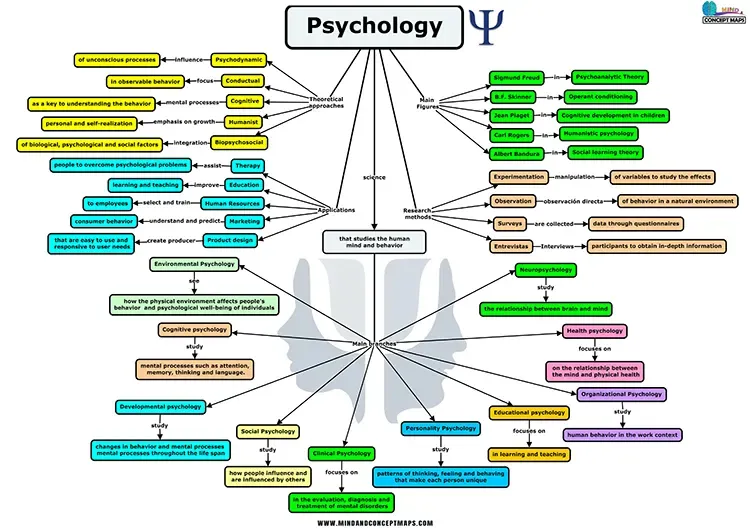Psychology, as the science of behavior and mental processes, unfolds in a complex network of interconnected concepts. A valuable tool for visualizing this complexity is the Concept Map.
This graphic resource provides a clear and organized visual representation of the diverse branches, theories, methods, and applications that make up this discipline.
We will explore the concept of a Psychology Concept Map, highlighting its usefulness for students, professionals, and enthusiasts of this fascinating area of knowledge.
What is a Psychology Concept Map?
A Psychology Concept Map is a graphic representation that visually articulates the relationships between the diverse elements that compose this science.
From specialized branches to fundamental theories, through influential figures and research methods, this map serves as a structured guide that facilitates the comprehensive understanding of Psychology.
It is a dynamic tool that allows not only to visualize connections, but also to understand the interdependence and complexity inherent in the discipline.
Download the free image of the Psychology Concept Map, so you can use it in your projects, guide on how to make your own and understand the subject better.
👉 Download the new conceptual map of the history of psychology for free
Psychology Concept Map and its branches for free download
How do you make a concept map for psychology?
A psychology concept map is a visual tool that allows you to organize and understand the key concepts of this discipline. It is an effective way to synthesize information and visualize the relationships between different topics.
Here is a step-by-step guide to creating a concept map in psychology:
- Choose a topic: Decide what psychology topic you want to represent in your concept map. It can be a general topic, such as "psychology," or a more specific topic, such as "long-term memory.
- Research the topic: Gather information about your chosen topic. You can read textbooks, academic articles, reliable websites, or consult with experts in psychology.
- Identify key concepts: From your research, identify key concepts related to the topic. These concepts can be terms, ideas, theories, processes, etc.
- Organize the concepts: Decide how you will organize the concepts in your concept map. Ideally, use a hierarchical structure, for example, placing the more general concepts at the top and the more specific ones at the bottom.
- Create the concept map: Use a digital tool such as CmapTools or draw your concept map by hand. You can use different shapes and colors to represent the concepts and the relationships between them.
- Review and edit your concept map: Make sure your concept map is clear, concise, and easy to understand.
The Psychology Concept Map emerges as an essential tool for those who wish to explore and understand the breadth of this science.
It offers an organized perspective that facilitates the assimilation of key concepts and the understanding of the interconnections that define Psychology.
Whether for students who are new to the discipline, professionals who seek an overview or enthusiasts who want to deepen their knowledge, this concept map presents itself as a visual compass that guides through the fascinating landscape of the human mind and its countless facets.

